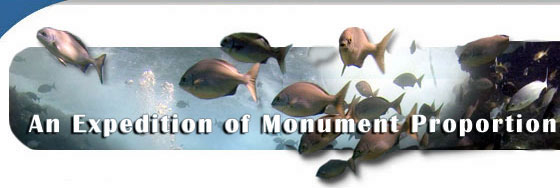|
Mission Log: June 27, 2006
Trilateration in Maritime Archaeology
Paulo Maurin
University of Hawaii
Dena Deck
Alumni NOAA Teacher-at-Sea
Bellflower Unified School District Teacher
In maritime archaeology, as well as in real estate, it's all about location, location, location. Whereas in the towns and cities we use roads to locate a house, when studying a shipwreck, maritime archeologists use a method called “trilateration.” Dr. Hans Van Tilburg, Pacific Islands Region Maritime Heritage Program Coordinator, explains “trilateration is the technique we use to record the precise position of artifacts and their distribution on a wreck site. It’s a hands-on, relatively simple method for divers to map out these artifacts on the bottom.”
 |
| Sketch showing trilateration of an object on deck using a baseline. (Photo: Paulo Maurin) |
A shipwreck, much like a car accident, is often the product of a violent event. And once a ship is on the ocean’s bottom, wood decomposes and metals rust. The remains of a ship are scattered by currents and inhabited by animals. It often takes many years, hundreds of years sometimes, before these remains are seen again. A shipwreck no longer resembles its original shape, and its many parts are found far from the original structure, and some are never found again. How would you locate all these remnants?
 |
| Maritime archaeologists train by measuring objects on the ship's deck. (Photo: Paulo Maurin) |
First, start with a baseline. A baseline is a temporary line, a reference for the position of all artifacts in its vicinity. It consists of a measuring tape placed temperately at the bottom of the sea floor near the wreck. Once this baseline is set, transect tapes are used to measure the distance to every artifact. For objects within 3 meters (approx. 10 feet) of this baseline, a single transect line is used, placed at right angles to the baseline. For objects which are farther away, two transect lines are placed, each beginning at different points on the baseline, forming a triangle. This triangle can be relocated on graph paper, plotting each artifact’s position with accuracy. For small objects, only one reference point is required (one triangle). For larger objects, such as an anchor, two reference points are used to have an idea of the size and orientation of the artifact, each point requiring two transect lines and yielding two triangles. For each transect line, the distance from the baseline is measured and drawn, underwater, on water-proof paper. At the end of a dive, all measures and drawings are combined into a single diagram of the wreck. What can you find at a shipwreck? Cannons, anchors, boiler pieces, fasteners, and rigging.
 |
| Maritime Archaeology Team members: Dr. Kelly Gleason, Lindsey Thomas, Dr. Hans Van Tilburg, Tane Casserley, Robert Schwemmer, Brenda Altmeier. (Photo: Paulo Maurin) |
Find, locate, measure, draw. It might sound simple enough, but when you are working with a team of people underwater, communication is limited. Everyone on the team has done this before, but not together. Dr. Van Tilburg mentions the importance of team practice by noting that “Some of [the] team is from Florida, some from the West coast, but it’s good for us to practice this because we all have our tricks and gimmicks and we want to make sure we are on the same page of who’s doing what underwater, because you do this these things on dry land, it all seems very simple, but as you well know, when you get on the water, everything gets twice as difficult.”
Because the amount of artifacts related to a wreck are large, and bottom time is limited, marine archaeology teams often cannot fully catalog an entire site on a single cruise, and often have to come back to it several times. When dedicated teams of scientists return to the neighborhood to continue work, they grow more familiar with the area and artifact, a site of past human history and tragedy under the waves. It’s all about location, location, location.
|



